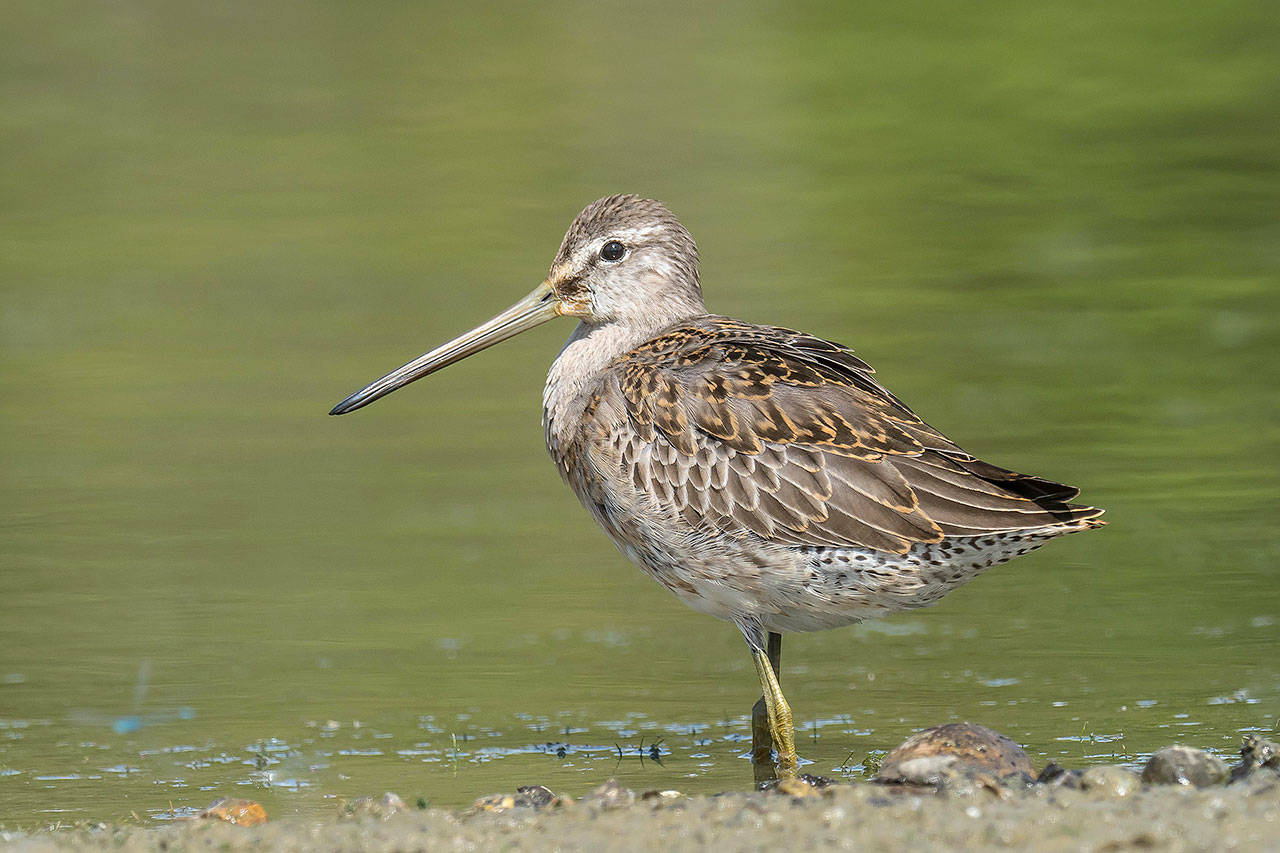By Dianna Moore
Grays Harbor Audubon Society
Both the Long-billed and the Short-billed Dowitcher can be found here on the Harbor and every time I am with birders who find one or the other it is a real test to see how the bird is (hopefully) correctly identified. The female’s bill is longer then the male of both species, but the bill of the female Short-billed Dowitcher is about the same length as the bill of the male Long-billed Dowitcher. So unless you are fortunate to have the two species side-by-side for comparison, you are in for a lot of probabilities. The best distinguishing item is in their calls. You can listen to them at the Cornell Lab of Ornithology’s web site. Meanwhile this photo by Gregg Thompson gives one the general characteristics of the bird.
General description: A medium to large shorebird with long legs and a long bill twice the length of its head. The Long-billed in breeding plumage usually has some barring rather than spotting on the side of its breast in front of the wing and the belly is reddish all the way back to the base of the tail. The non-breeding plumage is more grays and mottled brown. One other distinguishing characteristic is the non-stop chatter among the Long-billed Dowitchers and the relative silence among the Short-billed. This bird is 11.5 inches in length with a wingspan of 19 inches, and weighing approximately 4 ounces.
Habitat: I winter and during migration these birds are usually found in fresh-water marshes inland, or in pools along the coast where they can be seen in salt marsh vegetation. They breed farther north and west than Short-billed Dowitchers in grass- or sedge-dominated tundra marshes in Arctic coastal regions in Alaska.
Behavior: Long-billed Dowitchers feed by walking slowly, probing their long bills into mud or shallow water up and down in a sewing machine fashion. Their bills are full of nerve-endings, the better to sense their buried prey. They are usually found in smaller flocks than the Short-billed Dowitchers, but many large flocks of Short-billed Dowitchers also contain a few Long-billed birds. Their calls are more often a single high peeping sound but they may also repeat the call.
Diet: On their breeding grounds, Long-billed Dowitchers eat aquatic insects and insect larvae. On mudflats they also eat mollusks, crustaceans, marine worms, and other aquatic invertebrates.
Nesting: Long-billed Dowitchers usually nest on the ground near water in a deep scrape on a bed of moss or grass, and lined with sedge or grasses. Both parents incubate the four eggs for 21 to 22 days. The young leave the nest within a day of hatching and can find their own food. But the parents tend the young but the female leaves shortly afterwards, and the male is left to tend the young alone until they are ready to fledge at 20 to 30 days. The pair have just one brood a year.
Migration: These are medium-distance migrators. They come through Washington later in the fall than their shorter-billed relatives, and they winter along the Atlantic and Pacific Coasts. Some first-year birds stay on the wintering grounds in summer.
Conservation status: Over-hunting contributed to declines in the late 1800s and early 1900s, but protection from hunting has resulted in a rebound. Range-wide, the number of migrants has increased, and the breeding population has recently expanded into Siberia. It is not fully understood whether this is a shift from other nesting areas, or a true expansion. Habitat loss and environmental contaminants also threaten the current population of Long-billed Dowitchers.
Where and when to find on Grays Harbor: The Long-billed Dowitcher is less common during migration than the Short-billed Dowitcher, but is the more common winter resident in major estuaries on the Washington coast. Coastally, the first adult migrants start arriving from the north in July and are common from July into mid-September. Juveniles start migrating through in mid-August and are common through October. They are uncommon from November through April. The spring migration is short, and birds are common for only a few weeks in the beginning of May. Once again, the more likely place to spot this bird is along the harbor estuaries, the John’s River Wilderness Area, the Oyhut Wilderness Area, and our perennial favorite birding locations, our sewage treatment ponds. Watch for the sewing machine motion!


